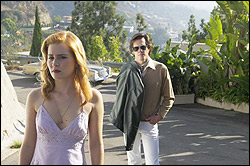Nancy Drew, now all grown up and living in 1972 Los Angeles: beachfront apartment, golden curls, serious babe, sometime toker, not opposed to the occasional ‘lude, but still righteously determined to solve the big mystery. Only this mystery occurred 15 years before, in Miami, and our girl detective is now a magazine journalist, Karen (Alison Lohman). She narrates parts of Truth, as do its two main suspects, Vince (Colin Firth) and Lanny (Kevin Bacon), who are obviously modeled on Dean Martin and Jerry Lewis. (“We weren’t just heroes, we were gods,” Lanny helpfully explains.) Rupert Holmes wrote the 2003 source novel for Atom Egoyan’s ploddingly by-the-numbers echt exposé, which plays like a young-adult novel with three-ways and Benzedrine binges. Karen is an Irish-Catholic moralist, which links her to student journalist Maureen (Rachel Blanchard), who famously turned up dead in Vince and Lanny’s hotel suite in New Jersey following their triumphant 1957 polio telethon in Miami, destroying their partnership.
Why Miami, why not New Jersey, why now, why Martin and Lewis, who never did anything mean to Egoyan (Ararat, Exotica), so far as I know? Lewis, now 79, has a new and adulatory book out about his late partner, which understandably suppresses the offstage sex and drugs that surely accompanied any big showbiz act of their era. I don’t think anyone who laughed at their antics seriously believed they were saints, yet Egoyan insists that intrepid, naive Karen has just that kind of reverence for her idols, Lanny in particular. “It must be weird to find that the object of all your adolescent fantasies is a pig,” says her roommate. Yeah, right, if you were raised in a convent, Sister Karen.
Lohman’s innocence here isn’t much more convincing than her tough-girl act in White Oleander. Bacon and Firth, on the other hands, are total pros—like their role models. In Lanny, Bacon shows us both the thin-skinned spastic of the nightclubs and, later, the wise and wary showbiz survivor who makes seducing a young journalist seem less inevitable than it really is. Using his normal British accent, Firth isn’t so closely modeled on the dark, dissolute Dino of the Nick Tosches biography; he’s mostly got the emotional curtains drawn—though, ironically, he later lives in the fabulously airy and transparent Stahl House, a modernist icon overlooking L.A.
Should we be shocked, shocked, like Karen at the orgies and the license taken by stars? Egoyan tries to side us with her, the one journalist with any integrity in the piece (never mind the part about sleeping with your sources), even if we prefer that certain stories not be written, that stars be left with a little mystery, perfumed by scandal. Truth loops back and forth between the late ’50s and early ’70s, and it does achieve a certain twilight-of-the-gods poignancy in the latter decade. There’s period pleasure in the IBM Selectrics and reel-to-reel tape decks, the first-class cabin on a Pan-Am flight where the chairs swivel to face pop-up tables for formal dining. Firth’s salt-and-pepper moustache reminds one of Burt Reynolds, and Bacon takes to wearing a scarf with his crisp polyester jackets. They still know how to entertain an audience.
But give me the fabulous falsity of appearances, not the dull truths behind. Egoyan has chosen the right icons, and at the right moment of their fading glamour; he just doesn’t know what to do with them. Instead of being hounded by a little blond sleuth, you want Vince and Lanny to fly, fly away into the sunset they deserve. (NC-17)








